Everyone wants a dragon pet or a dragon pal, but the truth is, dragons don’t need us. In your average fantasy narrative, dragon species are perfectly capable of surviving and thriving without human interference. Some even have their own advanced societal codes and structures.
We wish we could live among them, but most of these dragon clans would just give us the cold shoulder, if we were lucky…
How to Train Your Dragon

The story of Hiccup finding his very own Night Fury is warming to even the most cynical of hearts, but the second film widens the scope of the dragon world. Hiccup discovers that his mother has helped create a secret dragon society by rescuing various species from Drago Bludvist, who was trying to capture dragons to form his own personal army. After a massive battle, Toothless becomes the alpha of all the dragons, defeating Drago’s Bewilderbeast and saving the day. But it’s not over! In the third installment, Hiccup works with Toothless to finds a rumored “Hidden World” for dragons, where they can be safe from human influence and control. They manage to find that place—and a mate for Toothless—and Hiccup eventually has to say goodbye to his friend, knowing that humans are not capable of coexisting with dragons at this point in time. Hiccup vows that he and his people will guard the secret of the dragon “Hidden World” until humanity is ready to live side by side with these incredible creatures.
Dealing With Dragons by Patricia C. Wrede
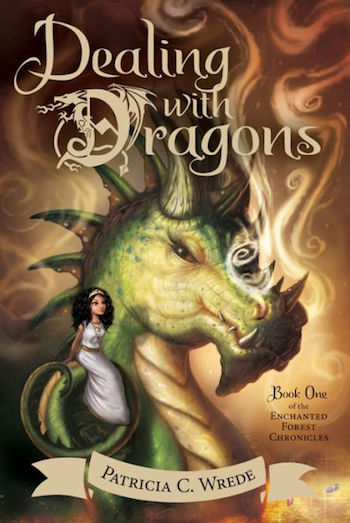
When Princess Cimorene balks at the idea of an arranged marriage to a prince, she decides to make a deal with a dragon named Kazul and becomes her princess. This deal is not an uncommon one in their world, and Kazul uses Cimorene as a housekeeper of sorts, for cooking and organizing books and treasure. Most people assume that Cimorene wants rescuing, but she’s quite pleased with the arrangement. An encounter with a wizard lets Cimorene in on a plot that threatens her new equilibrium: The wizards are gathering dragonsbane, and Cimorene brings it to Kazul for identification, accidentally making the dragon sick. Their information comes too late, and the King of the Dragons is poisoned and killed, leaving an ill Kazul to participate in the trials for who will become the next king. In this society, “king” is not a gendered term, and with help from Cimorene and friends, the wizards are defeated and Kazul becomes the King of the Dragons. Dragons have a lot of power in this particular world, and are found in later novels negotiating with various species and protecting castles with magical bubbles.
Buy the Book
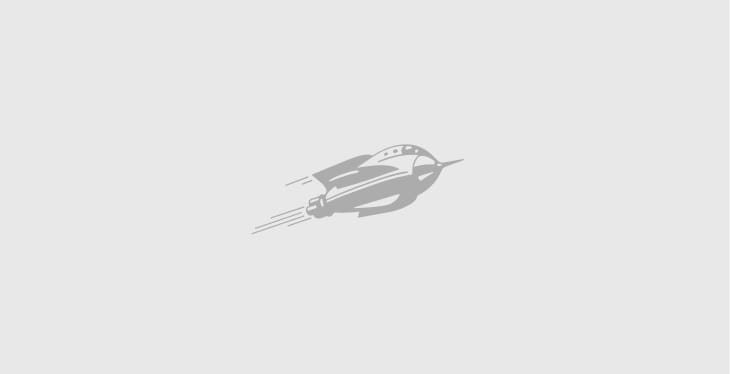

Dealing With Dragons
Turning Darkness Into Light by Marie Brennan

Set in the same world as The Memoirs of Lady Trent, Isabella’s granddaughter Audrey Camherst is taking up the family mantle by deciphering a series of ancient tablets that may give humanity more information on the Draconean civilization of yesteryear. Brennan’s universe asks the reader to view dragon society from an anthropological prospective, through the eyes of those who study them, beginning with Lady Trent’s first encounter with a Sparkling (which she must preserve in vinegar to prevent it from turning to ash) and carrying on through her more exciting discoveries about the world of dragons. Now her granddaughter is uncovering a conspiracy at a point and place in time when anti-dragon sentiment is rising and her work could be very important to the future. In this world dragons are very similar to wild animals that real zoologists find themselves studying—and they are vulnerable to the same dangers that real-world animals have when sharing the planet with humans. It is only by learning more about them that Audrey and her grandmother can prevent humanity from doing what it is wont to do when nature stands in its way.
Buy the Book


Turning Darkness Into Light
A Wizard of Earthsea by Ursula K. Le Guin
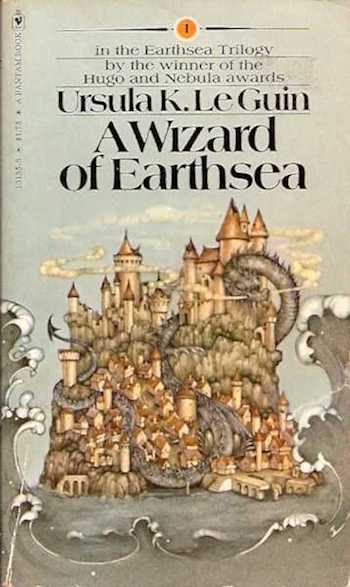
In Earthsea, Dragons and Men were once of the same race, but they split eons ago. By the time our hero Ged begins his wizard training, dragons are frightful, long-lived creatures, who make their homes in the West, keeping their own company and minding their own societies. But sometimes they’ll venture East, closer to human habitation to ransack homes, and generally causing terror. Because of this, one of the occasional tasks of the professional wizard is to drive them back. A Great Dragon makes its home in the ruins of Pendor Island (whose awesome history also includes being the home base for a pirate) and allows its eight wyrmlings to wreak havoc, destroying the buildings and making the people of a nearby town called Low Torning very, very nervous. The young wizard Ged makes part of his reputation by confronting the dragon, first by killing a couple of the wyrmlings, and then by telling the dragon his True Name (Yevaud, in case you ever run into him), which gives him just enough of an upper hand to force a truce. The Dragon tries to barter with Ged, but the wizard proves that he’s growing into his adult responsibilities by simply ordering Yevaud back West, where it can be among other dragons and leave humans in peace, rather than striking a deal.
Buy the Book


A Wizard of Earthsea
Avatar: The Last Airbender
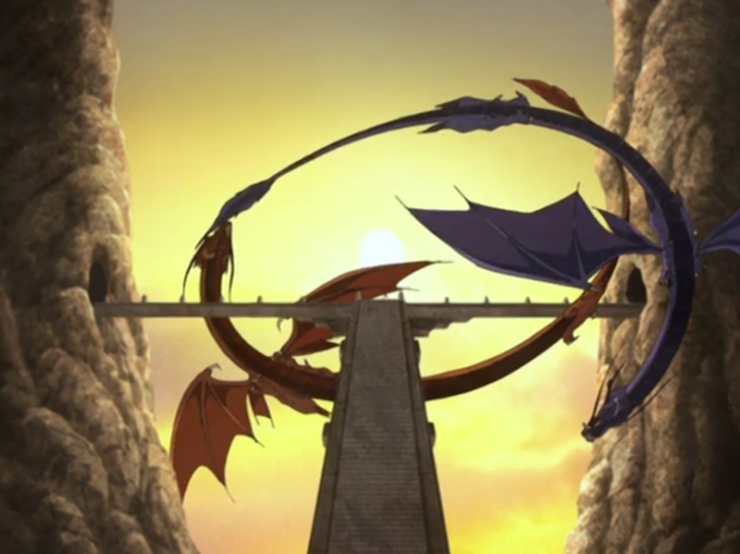
The dragons were an integral part of the world in Avatar: The Last Airbender before the Fire Nation hunted them as a proof of their own power. Avatar Aang and Prince Zuko eventually learn that Zuko’s uncle, Iroh, claimed to have killed the last dragon when he hadn’t—he met with the last two dragons and learned about firebending from them, then left them in peace. Not only did dragons have their own society and special knowledge in this world, their abilities as the world’s first firebenders caused certain humans to develop their own society inspired by the dragons: The Sun Warriors predate the Fire Nation by thousands of years, and they created the first forms of firebending that other users would study. The Sun Warriors understood firebending as the dragons did, knowing that the element was much more than a destructive and aggressive force, instead viewing it as an aspect of life and energy. But they kept their own culture a secret, much like the two dragon masters that they protect.
A Chorus of Dragons series by Jenn Lyons
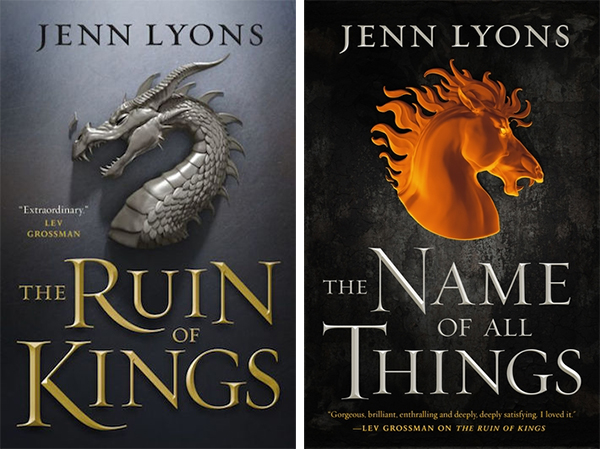
There is actually only one dragon that we’re introduced to properly in The Ruin of Kings, book one of Jenn Lyons’ series… but with Dragons, plural, right there in the series title we’ll likely be getting to know more of them in later stories. Often referred to as the Old Man (rude), the dragon Sharanakal has a peculiar habit: he captures people, traps them in stone, and then forces them to serenade him. Our young protagonist Kihrin ends up caught in such a position, with nothing to do but entertain. Which isn’t perhaps the kindest fate in the world, but if you’re captured by a dragon, we could certainly think of worse fates… While we’ve yet to meet other dragons, Sharanakal himself is a gigantic powerhouse—a force of nature that a human would be lucky to survive an encounter with. Which means that unearthing more of them could cause all sorts of trouble.
Buy the Book


The Ruin of Kings
Dungeons & Dragons
![]()
In Dungeons & Dragons lore, the Dragons tend to be solitary beings, content to swoop down and raid villages to grab cattle or treasure before returning to their private hoards. Adults will bond long enough to mate and care for their wyrmlings, but the couple usually splits up as soon as the babies leave the nest, and, since Dragons tend to consider themselves superior to other lifeforms (they’re not wrong) cross-species societies are nigh-impossible. But of course, there are always exceptions. “Chromatic” dragons will occasionally team up to hunt down a dragonslayer, or to fight “metallic” dragons. They’ll occasionally come together for religious ceremonies, as chromatics worship the dragon-goddess Tiamat while the metallics follow her brother, Bahamut. And then, too, sometimes a family will stay together and gather more individual dragons into a clan—according to The Draconomicon, the dragon Irril-Indriss lived in the Achlan Mountains with a dozen fellows, and was called the Thunder King by the humans who knew of him. There is even the occasional dragonborn empire, which is pretty much what it sounds like: an empire ruled by dragons (’cause who else would rule?) and populated by a complex hierarchy of other, less-powerful dragons, humans, goblinoids, etc. whom the dragons have chosen to tolerate. We’ve certainly heard of worse systems of government.
The Temeraire Series by Naomi Novik
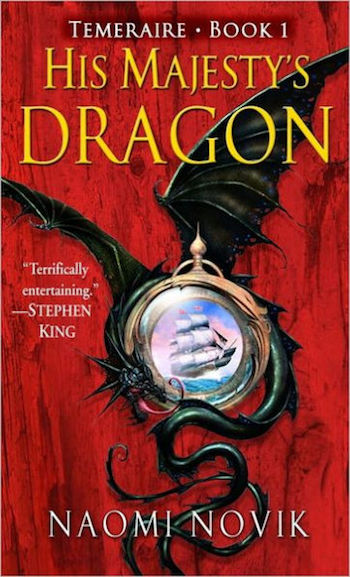
Set in an alternate history where dragons exist side by side with humans and are used as a form of military might in a Napoleanic Wars, Novik’s Temeraire series features numerous dragon species throughout the world. Some live in the wild and have their own languages, but those exposed to humans learn their languages while still in the shell, and some are very quick to pick up new ones. Dragons that are raised by humans will often imprint on a human companion, either by being given a meal when quite young, or being allowed to chose their own companion after a thorough education process. These bonds are extremely close, as dragons are incredibly possessive; what is normally extended only to treasure and wealth in any number of fantasy stories, the dragons of the Temeraire universe extend to people, even sometimes becoming jealous of their human’s relationships with other people. Some human cultures treat dragons as nothing more than tools, while others leave them be, fold them into society as valued citizens, or even worship them.
Buy the Book


His Majesty's Dragon
The Dragon Pit Chronicles by Jane Yolen
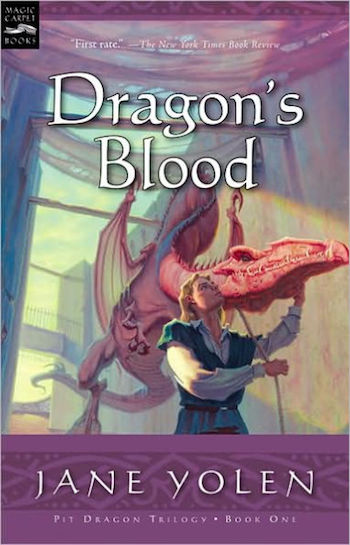
The Dragon Pit Chronicles work as a counterpoint to the rest of this list, because Yolen gives us a world in which dragons are not allowed to have a society. In the far-future, on the far-off planet of Austar IV, human colonistshave to fight a harsh environment to survive. This has resulted in a brutal society that churns along on the engine of slavery. And one of the quickest ways to make coin and buy your freedom? Training a dragon to fight in the Pit. The society’s dietary staple? A Stew made form the dragons who have failed in the Pit. This system continues, seemingly unchangeable, despite the humans knowing that the dragons are intelligent, even sentient—it’s just how life has to be. Over the course of the chronicles, we follow Jakkin, a young enslaved boy who first trains a stolen dragon for money, then comes to love his dragon and learns to communicate with her. He eventually ventures to a different colony, where dragons’ lives are quite different, but just as grim, as they are back home. The undercurrent of the books, however, is that left to their own devices the dragons would have their own way of life that humans cannot know.
Buy the Book


Dragon's Blood (Pit Dragon Chronicles Book 1)
Dragonriders of Pern by Anne McCaffrey

Pern may be the one dragon society on this list that is truly symbiotic. Humans and dragons need each other: the dragons would not be what they are without human intervention, but the humans wouldn’t be able to survive at all without the dragons. Pern is similar to Earth in many ways—which is why the humans attempted to settle—but one definite improvement on life on Earth came when they found little fire-breathing lizards that looked like smol versions of a certain Mythical Beasts. The first colonists dubbed them dragonets in tribute. Soon after the colonists settled they discovered that due to a planetary anomaly, Pern would be victim to a Thread Fall, a deadly showers of spores, every 200 years. Luckily, they realized they could fight Thread with fire, and even more luckily, one of their scientists, Kitti Ping Yung, was able to remix dragonet DNA until the humans had access to giant, sentient, highly-empathic creatures. Protected by the dragon’s fiery breath, and flamethrower-wielding Riders, humans are able to create a new, cooperative society, that thrives by the two species working together.
Buy the Book


Dragonflight: Volume I in The Dragonriders of Pern










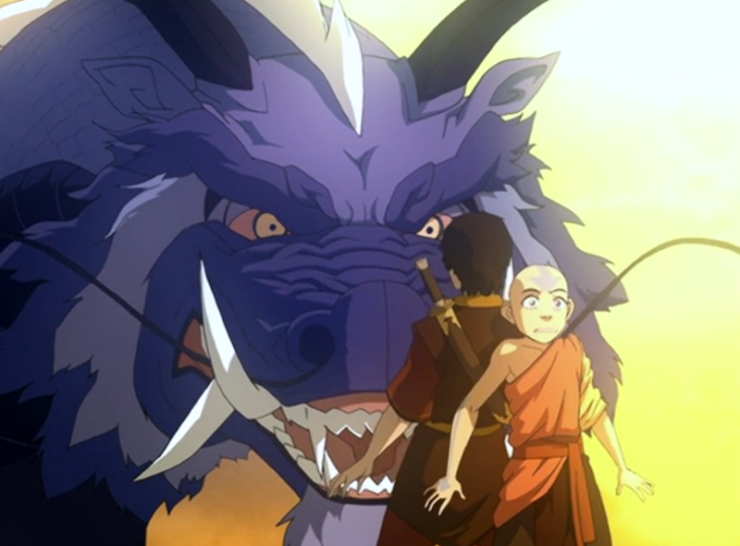
How to train your Dragon and the sequel nicely done
For anyone who’s interested in YA, I strongly recommend reading Wrede’s original Talking to Dragons from 1985 that became “book four” of the series – I found books 1-3 to be far more lightweight and disappointing, very much phoned in. Her Marelion duology on the other hand is all kinds of fun.
As for the rest of the recommendations, who doesn’t like a good dragon?
You should really do your research, or at least read one of the books in the series. The small, fire-breathing, flying lizards that were found on Pern are called fire lizards in all of the novels in the series (when they are mentioned at all).
@3
In the first book, Dragonsdawn, they’re referred to as “dragonets” by everyone except Sean, who calls them fire-lizards.
@3–In Dragonsdawn, the original Pernese colonists do in fact call them “dragonets” following their discovery. It’s mentioned at some point that a few colonists prefer to call them “fire-lizards”, but “dragonet(s)” is much more common. “Fire-lizards” is the term used by F’nor and his fellow riders and weyrfolk when the creatures are rediscovered in Dragonquest, which takes place almost two thousand years later. Since they were considered almost mythical by that point, the original name for them is probably long-forgotten.
Dragonrealm series by Richard A. Knaak. The series deals with the struggle when the Age of Dragons gives way to the Age of Men.
Thanks for reading my musings.
AndrewHB
I am stunned that Tooth & Claw, by Jo Walton, does not appear on this list, because it’s an amazing book.
As the author has described it, it’s a “sentimental Victorian novel about dragons who eat each other”. Definitely a society of dragons, and highly recommended.
What about Jo Walton’s Tooth and Claw?
Another one missing would be Graham Edwards’s Dragoncharm (which had a sequel, IIRC, Dragonstorm): two factions of dragons, the Natural (magicless) and Charmed (magic-endowed), live in separate societies. The world shifting away from magic causes the Charmed to go almost entirely insane; it’s up to a Natural and a Charmed to travel together and find a way to save their kind. (The book wasn’t really my favorite, TBH, but it did feature dragon societies.)
And venturing toward SF territory, Jeffrey A. Carver’s Dragons in the Stars and Dragon Rigger, part of his “Star Rigger” universe, have a society of dragons living in hyperspace, using the properties of the dimension to work what is essentially magic.
Sarah Beth Durst’s YA story Fire & Heist has “wyverns” in human form, exiled to Earth and living among us, complete with a cult of celebrity around their exploits. (Just where there were exiled from, and why, and what happened to their shapeshifting abilities, form a key part of the plot and the society they’ve built up on Earth.)
James Maxey’s Dragon Age had dragons ruling over humans.
Then there are Robin Hobb’s dragons in her Farseer universe, featured in the Liveship Trader trilogy and Dragon Keepers books.
Hasbro’s Kaijudo series has the Fire Civilization ruled by dragons (and most of its people are a related semi-humanoid race, called drakons). In fact a major plotline through the cartoon is about the succession; Emperor Napalmeon is dead to begin with, leaving a legitimate daughter (Moorna) and an illegitimate half-breed son (Tatsurion). Moorna and her fiancé Brutalus attempted to kill Tatsurion’s non-dragon family, and Brutalus was maimed when Tatsurion fought back*. A crippled dragon is exiled, and a daughter can’t inherit the throne (she needs either a husband or a Lord), so Moorna “the Vengeful” has two reasons for wanting the death of Tatsurion “the Unchained”…
(* Surprisingly, Brutalus has no grudge; he admits he was in the wrong and would have done the same as Tatsurion.)
This list could never finish
Then there is Michele Sagara’s Chronicles of Elantra where Dragons are one of the non-human races and rule the empire with a complex society of their own.
There was a 2nd Edition AD&D campaign setting (name escapes me, but it was one of those one-off boxed sets that were thick on the ground at the time) where everybody (including the PCs) was a dragon, although IIRC the assumption was that most folks spent most of their time shapeshifted into human form.
If you were stretching the term, you could include the Vlad Taltos books by Steven Brust, but that’s actually a House of elves, although it is mentioned that they were created with some dragon DNA.
Elizabeth Kerner’s trilogy Song in the Silence, The Lesser Kindred, and Redeeming the Lost are a beautiful take on dragons. The dragons have been living in self-exile on a far island for unknown ages, but every so often humans make an expedition to harvest a plant that is a medical miracle worth its weight in silver. Most of those people go for the profit, but the narrator goes because she wants to meet the dragons… despite the fact that crossing the boundary fence on the island is a death sentence. And there’s an evil sorcerer and an ancient curse from an even worse one…
I think you need to include Robin Hobb’s Dragon Keeper and Liveship books. From the worm sea serpent to the full fledged dragon they have a specific society and hierarchy. They are great stories. If you have not read them I highly recommend all of her connected works.
What about the Inheritance series by Christopher Paolini?
I’m always harping on about this vastly underrated or under reviewed series but the Memory of Flames sequence by Stephen Deas – particularly Dragonqueen (my personal favourite) – features dragons of a whole other level of awesome, and humanity finds that it is nowhere near as big and clever as it thinks it is.
Carrie Vaughn’s “Voices of Dragons”
And its sequel.
The age of fire series by e. E. Knight. It tells its story from the point of view of the dragon characters rather than from the human characters.
Definitely a couple on here I wasnt aware of. I have also quite enjoyed the Heartstrikers series by Rachel Aaron (#1 Nice Dragons Finish Last) – it is modern-ish day after magic returns to earth.
I like the dragons in Diane Duane’s ‘Door’ series – huge creatures that mostly don’t take account of humans – until one, at the point of death, has to pass his memories to a human woman because no other dragon is around at that point. The woman – Segnbora – is part of a group helping an exiled prince regain his kingdom, and the dragon, Hasai, becomes a part of that. We get only glimpses of dragon society, but they play an important role in the story.
(Also, please – sapient. Not sentient!)
My personal favourite dragon society is from Dickson’s The Dragon and the George series. I’m surprised by the inclusion of the Wizard of Earthsea as dragons aren’t a large part of the book and we don’t learn much about their society.
Contrast to something like TDATG (well, more so in the sequels) where at least two dragons are important characters and we spend time learning about dragon mores and with a dragon “parliament”.
Diana Wynne Jones’s Dark Lord of Derkholm and Year of the Griffin also have a dragon society, although it’s not in the foreground.
The Dragons of the Cuyahoga, anyone? From the “Cleveland Portal” series, aka the “Dragons & Dwarves” series by S. Andrew Swann. This wasn’t a series when I first read it… But I enjoyed it so much that I stuck around for “The Dwarves of Whiskey Island” and then backtracked the rest of his work. Until I did that, I never realized he was the author of another personal favorite, The Moreau Triilogy (now a quadrilogy.) Run, don’t walk to read any and all!
Sarah Hoyt’s Magical British Empire series features human/dragon shifters in an alternate British Empire. Dragons aren’t exactly integrated into the Raj, but they are players in the Great Game.
Her Shifter Series features dragon shifters and other were creatures. The have cultures of their own, concealed in a Colorado college town.
Barbara Hambly’s Dragonsbane, a most excellent explanation of dragons and their lives.
Dragons of Spring Dawning aka Dragons of Krynn as in the Dragonlance Realms. Worlds of Dragons to explore there!!! Good ones and Bad ones!!! Don’t want forget to mention GOT!!! Even though we never get to know the dragons, they are the focal point alongside the Iron Throne!!!
I’d like to suggest an addition to this list: Allison Goodman’s Eon series.
The dragons in Demoniac Dance by Jaq D. Hawkins are worthy of mention because a world where goblins and dragons carve out a symbiotic existence is unique. Also for those who like short stories, the Dreamtime Dragons Anthology is worth a read.
Eileen Wilks’ World of the Lupi is my favourite series with dragons.
I’m also surprised Sherrilyn Kenyon didn’t make the list.
I have fond memories of Christopher Rowley’s Bazil Broketail series of books.
There are dragons (very strange ones) in Foz Meadow’s A TYRANNY OF QUEENS.
I’m quite fond of the “Dragons” in “Glory Road” by Robert Heinlein.
Whilst not a major part of the story, they do contribute in their own way to the growth of the Hero.
I loved Dragons: A Fantasy Made Real;
The documentary traced the evolution of various species of dragons. And their gradual extinction.
A second story line followed the discovery and autopsy of a dragon, frozen in a Carpathian cave.
Patrick Stewart did the voiceover.
@35 Wayne Hanks
What was special about the dragons in Glory Road? I may be mis-remembering, but I thought they were just kind of standard dinosaur-ish monsters. We get a tiny bit of detail about a mother-child dragon relationship but do we ever learn anything more about dragon society?